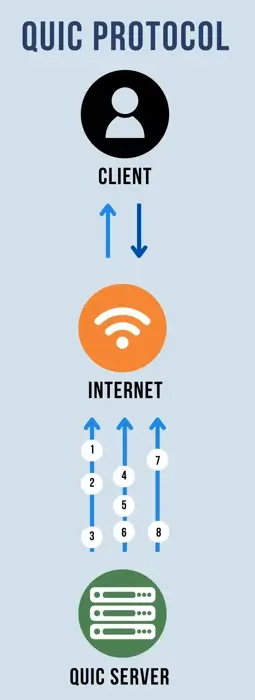What Is QUIC? QUIC Protocol Explained
Many ideas have been thrown around to improve the reliability of web connections. QUIC is the new transport layer network protocol designed to make web traffic more secure, effective and quicker. It's built on top of UDP instead of TCP to improve Internet services. In this article, learn what QUIC is, how it works, and why this new protocol matters.
What is QUIC?
QUIC, which stands for Quick UDP Internet Connections, is a cutting-edge transport layer network protocol created to improve the performance and security of Internet communication. It accelerates HTTP traffic and makes it more secure.
Unlike Transmission Control Protocol (TCP), which operates over IP, QUIC leverages connectionless-oriented UDP (User Datagram Protocol) to establish connections. The standard replaces the TCP and TLS on the web. Every Internet service where every millisecond matters should significantly benefit from Quick UDP Internet Connections compared to TCP and TLS.
In the OSI model, QUIC works at layer 4, or the transport layer. Because of this, it’s a transport layer protocol that provides a more robust communication experience.
As a low-latency transportation protocol, QUIC suits applications that require immediate response. By extension, Quick UDP Internet Connections adds some changes that assure a faster online user experience.
Development of QUIC
The QUIC protocol was initially developed by engineers at Google in 2012 as an experimental protocol to enhance web performance. The search engine giants deployed the protocol in their server-side services, such as Google Search, Gmail, YouTube, and their in-house Chrome browser.

Since then, the Internet Engineering Task Force (IETF) adopted Quick UDP Internet Connections as RFC 9000 in May 2021, marking its official recognition as a standard Internet protocol. It is supported by RFC 8999, which defines the version-independent properties of QUIC, RFC 9001, which specifies the use of TLS to secure QUIC, and RFC 9002, which provides the loss detection and congestion control mechanisms for QUIC.
In June 2022, the IETF officially published QUIC-based HTTP/3 as a proposed standard in RFC 9114. QUIC aims to revolutionize data transmission over the Internet.
This standard protocol offers significant improvements over traditional protocols used in the current Internet infrastructure. The need to overcome the limitations of connection-oriented TCP, such as slow connection establishment, motivated the protocol's creation.
Big tech companies are adopting it to help make the online experience smooth for everyone. This protocol type is perfect for streamers, gamers, and anyone looking for practical solutions for day-to-day tasks.
How QUIC works
Quick UDP Internet Connections works in a way that replaces the communication flow components previously handled in TLS and TCP with QUIC and UDP. It takes over TCP's roles in loss recovery, congestion control, and connection establishment with its own mechanisms.
It takes the best security features of TSL 3.1, then adds the resiliency of TCP connections and implements them on UDP to streamline Internet services.
The QUIC network's architecture is proof of a flexible, efficient, and secure transport protocol. Consider the following overview of the key components.
UDP foundation
Quick UDP Internet Connections operates over UDP, encapsulating its data within UDP datagrams. A UDP datagram is the basic unit of transmission in QUIC. It contains:
- A source port, a 2-byte field that identifies the port number from which the datagram originates
- A destination port, a 2-byte field that specifies the port number that the datagram goes to
- Length is a 16-bit field that indicates the total length of the UDP header and the encapsulated data
- Checksum, a 2-byte field used for error-checking of the header and data to ensure data integrity during transmission
QUIC packet
Encapsulated within each UDP datagram is a QUIC packet, which comprises a packet containing a QUIC header and one or more QUIC frames.
- Header. Each packet has a header with information such as connection ID, packet number, and flags. The header is designed to be minimal to reduce overhead.
- Frames. The payload of a packet consists of frames. Frames can carry different data types, such as stream data, acknowledgments, and control information.
Streams
QUIC supports multiple independent streams within a single connection. A stream ID uniquely identifies each stream and can be either unidirectional or bidirectional. Streams allow data to be multiplexed. This means multiple data streams can travel concurrently over the same connection without interfering with each other.
Quick UDP Internet Connections integrates the transport and cryptographic handshake. This handshake is designed to be quick, requiring fewer round-trips compared to the separate handshakes in TCP and TLS.
It uses multiple encryption levels during the handshake process (initial, handshake, 0-RTT, and 1-RTT) to progressively secure the connection.
QUIC supports 0-RTT resumption so that clients can send data to a server immediately upon reconnecting without waiting for the handshake to complete. This is useful for reducing latency but comes with some security trade-offs, as it can be vulnerable to replay attacks.
The 1-RTT connections provide full encryption. Once the handshake is complete, this level is used for the bulk of the data transfer.
Basic features of QUIC protocol
QUIC is designed to optimize connection establishment and data transmission at its core. Here are some key technical aspects.
- Connection establishment. In contrast with TCP, QUIC reduces the round-trip time (RTT) required for connection setup by combining the handshake and encryption negotiation processes. On that note, there’s faster connection initiation compared to TCP.
- Transport layer protocol. Quick UDP Internet Connections operates at the transport layer with UDP as its foundation. It helps send data in discrete packets.
- Independent logical streams (multiplexing). QUIC supports multiple streams of data within a single connection, enabling efficient data transfer without the head-of-line blocking issues seen in TCP.
- Comprehensive encryption. The protocol mandates encryption for all connections. The goal is to ensure that all data is secure and private. QUIC integrates TLS encryption directly into the protocol, providing secure connections against eavesdropping from the start.
- Congestion control. The QUIC protocol incorporates advanced congestion control algorithms to manage network traffic effectively.
- Underlying protocol for HTTP/3. QUIC serves as the transport protocol for HTTP/3, the latest version of the HTTP protocol. HTTP/3 runs on top of QUIC, just as HTTP/1.1 and HTTP/2 run on top of TCP.
- Connection migration. Another of the protocol's core features is support for connection migration. This allows connections to survive changes in network conditions, such as moving from WiFi to mobile data, which is particularly useful for mobile devices.
QUIC vs. TCP and UDP
QUIC is worth choosing over the standard TCP/IP connection we've relied on for so long.
TCP establishes a connection through a three-way handshake, followed by TLS negotiation for encryption. Only then does will the data you are looking for start flowing. These initial steps involve multiple round trips between client and server, which theoretically introduces latency before actual data transfer begins.
In a world where speed is necessary, Quick UDP Internet Connections is poised to become more prevalent online. Google has announced that QUIC searches are, on average, one second faster than TCP searches.
With Quick UDP Internet Connections, there is no need to complete a complex handshake to initiate the first connection because the protocol uses UDP. While UDP is faster but less reliable, QUIC handles packet loss to guarantee a seamless user experience.
QUIC's advantage lies in its use of multiplexing, which sets it apart from TCP. In a head-to-head comparison, Quick UDP Internet Connections establishes multiple connections between two endpoints. If one QUIC stream is interrupted by a poor connection or other issues, the remaining streams can continue transmitting data. This effectively addresses the head-of-line blocking problem that has plagued TCP for decades.
Quick UDP Internet Connections performs slightly better than TCP. However, it's important to remember that TCP has been reliable for many years, while QUIC is relatively new. Given Google's resources and the fact that someone can implement QUIC at the application level, Quick UDP Internet Connections may soon surpass Transmission Control Protocol in performance and become the preferred choice for Internet communication.
QUIC vs. HTTP/2
HTTP/2, approved in 2015, brought major improvements over HTTP/1.1. It introduced multiplexing, allowing multiple requests and responses to travel over a single connection.
Besides, HTTP/2 introduced header compression to reduce server push and proactively send client resources. However, it still relied on TCP, which could suffer from head-of-line blocking, where a single lost packet delays all subsequent packets.
Quick UDP Internet Connections helps fix some of HTTP/2's biggest shortcomings. HTTP/3 is the third major revision of the developed and released protocol. It is essentially HTTP/2 over QUIC. At present, HTTP/3 enjoys full support for about 79% of all web browser installations.
HTTP/3 uses QUIC's capabilities. It inherits benefits like faster connection setup, improved multiplexing, and better handling of network changes. This makes HTTP/3 highly efficient, particularly in mobile environments.
Together, these protocols represent a progression towards faster web communication. They are considered new standards for modern web applications.
Benefits of QUIC
Several advantages make Quick UDP Internet Connections a superior choice for dependable connection over the web. They include the following.
- Speed and efficiency. Quick UDP Internet Connections significantly enhances the speed of Internet communications. Thankfully, it reduces connection setup time and optimizes data transfer.
- Improved security. With mandatory encryption and integrated security features, Quick UDP Internet Connections ensures that data transmitted over the network is secure from potential threats.
- Resilience to packet loss. The protocol recovers from packet loss more effectively than TCP. It maintains a stable connection even in challenging network conditions.
- Reduced latency: QUIC's handshake process requires fewer round-trips than TCP + TLS. This is especially beneficial for HTTP traffic, where reducing the time to establish a connection can improve page load times.
QUIC is beneficial in many different use cases. It's ideal for real-time applications such as video conferencing, online gaming, and live streaming. It shines in situations where robust performance is crucial.
It also works well with mobile devices; the connection migration feature makes it particularly beneficial for mobile devices that frequently change networks. The protocol also works well as a secure tunneling protocol for VPNs, and QUIC's lightweight design helps it achieve communication between Internet of Things devices.
Limitations of QUIC
Though helpful, Quick UDP Internet Connections does not come without challenges and concerns. For example, widespread adoption of the protocol requires updates to existing infrastructure and software, which can be complex.
Furthermore, ensuring compatibility with legacy systems that rely on TCP can be challenging, resulting in compatibility issues. QUIC can also struggle with performance in different network conditions. While Quick UDP Internet Connections performs well in most scenarios, its performance varies depending on network conditions.
Frequently asked questions
Is QUIC secure?
Yes, the protocol integrates encryption and authentication directly into the protocol with the aim of secure data transmission.
How does QUIC improve web performance?
Quick UDP Internet Connections boosts page load times through multiplex connection options, reduces latency, and improves resilience to network changes.
Can QUIC replace HTTP/2?
HTTP/3, which runs over Quick UDP Internet Connections, is designed to replace HTTP/2, offering better performance and security.
What are QUIC flood DDoS attacks?
QUIC flood DDoS attacks overload servers with encrypted QUIC packets over UDP. Due to encryption, they are similar to but harder to detect than UDP flood attacks.

